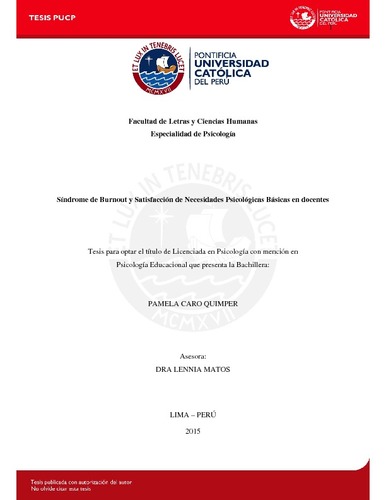| dc.contributor.advisor | Matos Fernández, Lennia | es_ES |
| dc.contributor.author | Caro Quimper, Pamela | es_ES |
| dc.date.accessioned | 2015-10-01T01:26:14Z | es_ES |
| dc.date.available | 2015-10-01T01:26:14Z | es_ES |
| dc.date.created | 2015 | es_ES |
| dc.date.issued | 2015-09-30 | es_ES |
| dc.identifier.uri | http://hdl.handle.net/20.500.12404/6294 | |
| dc.description.abstract | Esta investigación tuvo como propósito estudiar la relación entre el síndrome de burnout (desgaste emocional, cinismo y eficacia profesional), la satisfacción y frustración de necesidades psicológicas básicas (autonomía, relación y competencia) y las áreas de vida laboral (carga de trabajo, recompensa, comunidad). La muestra estuvo compuesta por 100 docentes de nivel primaria y secundaria de dos instituciones educativas; una privada y una pública. Se aplicaron tres cuestionarios para medir estas variables: Maslach Burnout Inventory – General Survey, Cuestionario de Necesidades Psicológicas Básicas y Cuestionario de Áreas de la Vida Laboral. Los instrumentos fueron válidos y confiables en la muestra estudiada. Se pudo corroborar a través de un análisis no paramétrico que el nivel de burnout era menor cuando el docente trabajaba en un ambiente laboral adecuado (menos carga de trabajo y mayor recompensa y comunidad) y sus necesidades psicológicas básicas estaban siendo satisfechas. | es_ES |
| dc.description.abstract | The purpose of this research was to study the relationship between the burnout
syndrome (emotional exhaustion, cinism and professional efficacy), the satisfaction or
frustration of psychological basic needs (autonomy, competence and relation) and the areas
of worklife (workload, rewards, community). The sample consisted of 100 teachers from
two primary and secondary schools; one private and one public. Three questionnaires were
applied to measure these variables: Maslach Burnout Inventory – General Survey,
Pyschological Basic Needs Cuestionnaire and Areas of Worklife Cuestionnaire. The
instruments were valid and reliable in the sample studied. Through a nonparametric
analysis, we were able to determine that there was lower levels of burnout when the teacher
was working in a suitable working environment (less workload, greater rewards and sense
of community) and the psychological basic needs were being satisfied. | es_ES |
| dc.language.iso | spa | es_ES |
| dc.publisher | Pontificia Universidad Católica del Perú | es_ES |
| dc.rights | Atribución-NoComercial-SinDerivadas 2.5 Perú | * |
| dc.rights | info:eu-repo/semantics/openAccess | es_ES |
| dc.rights.uri | http://creativecommons.org/licenses/by-nc-nd/2.5/pe/ | * |
| dc.subject | Personal docente--Stress profesional | es_ES |
| dc.title | Síndrome de Burnout y satisfacción de necesidades psicológicas básicas en docentes | es_ES |
| dc.type | info:eu-repo/semantics/bachelorThesis | es_ES |
| thesis.degree.name | Licenciado en Psicología Educacional | es_ES |
| thesis.degree.level | Título Profesional | es_ES |
| thesis.degree.grantor | Pontificia Universidad Católica del Perú. Facultad de Letras y Ciencias Humanas | es_ES |
| thesis.degree.discipline | Psicología Educacional | es_ES |
| renati.discipline | 313046 | es_ES |
| renati.level | https://purl.org/pe-repo/renati/level#tituloProfesional | es_ES |
| renati.type | http://purl.org/pe-repo/renati/type#tesis | es_ES |
| dc.publisher.country | PE | es_ES |
| dc.subject.ocde | http://purl.org/pe-repo/ocde/ford#5.01.00 | es_ES |






